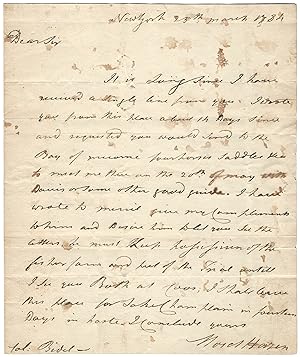Beschreibung
New York: 25 March 1784. Autograph letter, signed by Moses Hazen. Single sheet (8.75 inches x 14.5 inches), folded. 1 page + manuscript address panel (to Colonel Timothy Bidle at Haverhill, Coos) and docket. Old folds, contemporary ink smudges, and some light soiling. Small paper repair where the letter was opened. The letter, written shortly after the end of the American Revolution, reads: Dear Sir, It is long since I have received a single line from you. I wrote you from this place about 14 days since and requested you would send to the Bay of Micorne four horses, saddles, &c., to meet me there on the 20th of May with Davis or some other good guide. I have wrote to Merril. Give my compliments to him and Desire him to let you see the letters. He must keep possession of the fisher farm and put off the Trial until I see you both at Coos. I shall leave this place for Lake Champlain in fourteen days. In haste I conclude. Yours, Moses Hazen. Moses Hazen (1733-1803) is best remembered as the Brigadier-General in command of the 2nd Canadian Regiment of the Continental Army during the American Revolution. Born in Massachusetts, he served with the British Army in America during the Seven Years War, and then settled in Quebec where he purchased large tracts of land in Canada, New Hampshire and Vermont. When news of rebellion in the American colonies reached Hazen in early 1775, he allied himself with the Americans, convinced that his substantial land investments would be better protected. Raised to the rank of Colonel, he was put in command of assembling and directing the 2nd Canadian Regiment, composed of alienated Canadians from Quebec and Nova Scotia who sympathized with the American cause. The regiment later became known as the Refugees from Canada and Nova Scotia. When the 1776 attack on Montreal proved unsuccessful, Hazen and his Regiment retreated back to the American colonies, where they took part in battles against the British and earned an excellent fighting reputation. Hazen displayed extraordinary leadership qualities, and in 1781 advanced in rank to Brigadier-General. Hazen applied to get land grants for his troops, who were considered traitors in the eyes of the British for siding with the American Army: their land, homes and chattel in Canada were confiscated. The American government was deeply in debt and monetary compensation was hard to secure, but frontier land was plentiful and new settlers were welcome. In this light, Congress recognized the valuable contributions of the displaced patriot soldiers by creating the Canadian and Nova Scotia Refugee Tract in central Ohio, and by an Act passed on 7 April 1798 granted land to qualified soldiers. In the years that followed the American Revolution, Hazen fought Congress for compensation for his own losses in Canada: his estate had been pillaged by both armies, his manor had been razed to the ground, much of his land holdings were escheated, and he was still owed money extracted from his personal funds to recruit and maintain troops. His claim of more than $42,000 was never paid. Moses Hazen was an original member of The Society of the Cincinnati, a society founded in 1783 to preserve the ideals and fellowship of officers of the Continental Army who served in the Revolutionary War. Timothy Bedel (1737-1787) was Colonel of a Regiment at Coos, New Hampshire, for defence of the Coos Country (in present-day Vermont). Bedel was known as a brave soldier and respected leader, and raised more troops in the province of New Hampshire for service in the war of the Revolution than any other one man. Bedel assisted Moses Hazen on a number of fronts, including the 1779 construction of a road from the town of Haverhill on the Connecticut River northwest through Vermont and into Quebec just south of Montreal, for another planned invasion. The Bedel-Hazen Road was never completed as plans for another invasion of Canada were never executed. Bestandsnummer des Verkäufers 049
Verkäufer kontaktieren
Diesen Artikel melden
![]()

